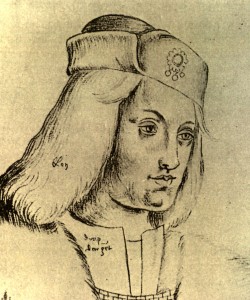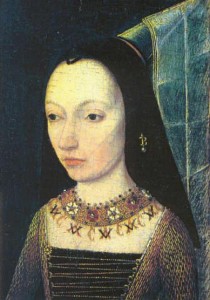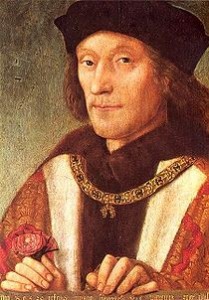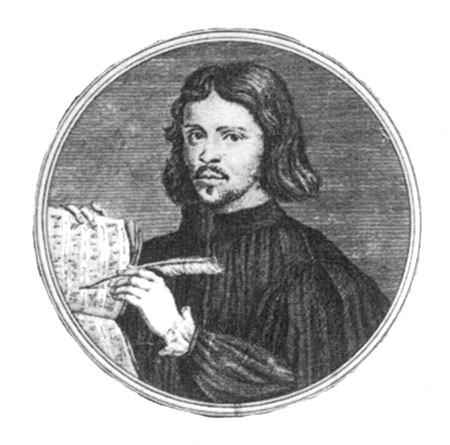
Perkin Warbeck
On 23rd November 1499, Perkin Warbeck faced his death at Tyburn. He was sentenced to be hanged until he was dead. His crime was attempting to escape the Tower of London where he was held a prisoner, but his story goes back several years and involves a tale of deception, treason and rumours of a young Prince come back to life!
In the Battle of Bosworth on 22nd August 1485, Henry VII had famously defeated Richard III in battle and won the English crown for himself and the future Tudor Dynasty. Richard III was dead and the fate of the Princes in the Tower, young Edward and Richard, sons of the late Edward IV, remained unknown. Many believed that they were dead, having last been seen two years previously. Others, however, hoped that maybe the young Richard, Duke of York, had been smuggled out of the Tower and across the channel to Europe. This is where Perkin Warbeck comes into the story.
Warbeck's earlier years remain a confusing story but it appears that the young man was born around 1474 to Jehan de Werbecque, a poor burgess of Tournai in Flanders, and his wife Katherine de Faro. Warbeck grew up in Antwerp and worked a series of jobs as a servant. After a time, Warbeck was hired by a Breton silk merchant named Pierre Jean Meno and was brought to Cork in Ireland around 1491. It was there that Warbeck learned English and when people saw him modelling his master's fine silks it was suggested that he was an illegitimate son of the late George, Duke of Clarence, or perhaps even Richard III.
The exact details of how Perkin Warbeck ending up claiming that he was Richard, Duke of York, the youngest of the Princes in the Tower, are sketchy. As Richard, Duke of York, Perkin claimed that his older brother Edward had been killed in the Tower of London but that he had been spared because of his young age and innocence. He had then been smuggled to Europe and protected by Yorkist sympathisers and sworn to secrecy.

Margaret, Duchess of Burgundy
Several European rulers, including Charles VII of France and Maximilian the Holy Roman Emperor, eagerly grasped onto Warbeck's claims and proclaimed the young man Richard, Duke of York, and true heir to the English throne. Even Margaret, Duchess of Burgundy, the widow of Charles the Bold and sister of the late Edward IV, supported Warbeck's claim that he was the youngest of the Princes in the Tower. Whether Margaret actually believed that Warbeck was her nephew remains unknown. Having not seen him for many years Margaret may have indeed believed that Warbeck was her long-lost nephew or she simply may have grasped at the chance to seek revenge against Henry VII who killed her brother at the Battle of Bosworth. Whatever the exact reason, Margaret took Warbeck in and saw him well educated in the way of the Yorkist clan.
On 3rd July 1495, funded by his "aunt", Warbeck took fourteen ships carrying around 6000 men to England in the hopes of claiming the throne for himself. However, when the ships landed at Kent, Warbeck's men were routed before Warbeck could even get to shore. Warbeck and his men fled first to Ireland and then to Scotland where he was warmly welcomed by King James IV. Since England was aligning itself with Spain in a marriage alliance between young Arthur Tudor and Katherine of Aragon, James IV saw an opportunity to align Scotland with their old friend France. James IV bolstered Warbeck's claim that he was the Richard, Duke of York, and saw Warbeck married to Lady Catherine Gordon, a distant cousin of the King, and granted him an annuity of £1200. It is unclear if James IV actually believed Warbeck's claims or if he just grasped an opportunity to cause havoc in England.
In September 1496, James IV, along with his army and Warbeck, invaded England under the claim of restoring Warbeck/Richard, Duke of York, as the rightful King of England. However, the support they wished to find in the North did not materialise and with his armies defeated Warbeck quickly escaped to Ireland. Then, in September 1497, Warbeck tried again. He and a small group of men landed in Cornwall where they hoped to raise men against Henry VII. Many people in Cornwall were upset over the huge levying of taxes by their King to pay for war. Warbeck was somewhat successful and was soon proclaimed King Richard IV. With an army of around 8000 men Warbeck passed Exeter and then Taunton, yet when he heard that Henry VII's army was close Warbeck fled in panic. He was finally captured at Beaulieu in Hampshire.
Henry VII chose to show kindness to Warbeck's wife, Lady Gordon, and placed her as a lady-in-waiting to his wife, Elizabeth of York. Warbeck was forced to make two public announcements at Westminster and Cheapside in June 1498 that he was not the late Richard, Duke of York, son of King Edward IV, and that he was in fact an impostor. When asked why he was impersonating the late Richard, Duke of York, all Perkin could say was that he blamed Margaret, Duchess of Burgundy.

Henry VII
At first, Henry VII showed some kindness to Warbeck and kept him at court until he tried to escape. Warbeck was quickly captured and taken to the Tower of London. There, he and Edward Plantagenet, 17th Earl of Warwick, son of the late George, Duke of Clarence, planned to escape. Their plan was soon uncovered and finally Warbeck's time ran out. On 23rd November 1499, under the charge of trying to escape from the Tower of London, Warbeck was taken from the Tower of London to Tyburn where he met his end by hanging. While officially the charge was trying to escape the Tower of London, in reality, if left alive, Warbeck posed a threat to Henry VII and his claim to the throne. For Henry VII, it was better to be rid of Warbeck once and for all rather than have him forever looming in the shadows.
Interestingly, Henry VII's wife, Elizabeth of York, older sister of the lost Princes in the Tower, was never called upon to deny the claims of Perkin Warbeck. In fact, there are no records or reports of her thoughts or feelings related to the whole affair. Did she believe that Warbeck was in fact her long-lost brother believed to have died in the Tower all those years ago? Probably not, but the claim that he was must have brought back terrible memories for the Queen. Whatever her lost thoughts were regarding Warbeck, the man from Tournai was dead and now only a memory, yet one that had touched a little too close to home.
Sarah Bryson is the author of Mary Boleyn: In a Nutshell. She is a researcher, writer and educator who has a Bachelor of Early Childhood Education with Honours and currently works with children with disabilities. Sarah is passionate about Tudor history and has a deep interest in Mary Boleyn, Anne Boleyn, the reign of Henry VIII and the people of his court. Visiting England in 2009 furthered her passion and when she returned home she started a website, queentohistory.com, and Facebook page about Tudor history. Sarah lives in Australia, enjoys reading, writing, Tudor costume enactment and wishes to return to England one day. She is currently working on a biography of Charles Brandon, Duke of Suffolk.
Sources
- de Lisle, Leanda (2013) Tudor: The Family Story, Chatto & Windus, London.
- Goble, Rachel (1999) The Execution of Perkin Warbeck, History Today, viewed 13 November 2015, http://www.historytoday.com/rachel-goble/execution-perkin-warbeck.
- Jokinen, Anniina, Perkin Warbeck (c.1474 – 1499), Luminarium: Encyclopedia Project, viewed 13 November 2015, http://www.luminarium.org/encyclopedia/perkinwarbeck.htm.
- Trueman, C. N. (2015) The Perkin Warbeck Rebellion, The History Learning Site, viewed 13 November 2015, http://www.historylearningsite.co.uk/tudor-england/the-perkin-warbeck-rebellion/.



One has to wonder though, about the relationship of Perkin with that of Edward Brampton, one of Richard III’s supporters. According to some historians, Brampton helped raise Perkin. I would be interested to know what the relationship between Brampton, Richard III and Warbeck- did it really exist? And if so, does this shed any new light on Warbeck’s identity?
Edward Brampton was in fact in the service of Edward iv but there is some controversial reading of how he was involved in this story. One story is that he took Prince Richard to Portugal with him after Bosworth, but this story has holes. Brampton did have connections to Portugal as he was a Jew who converted to Christianity. The York and Portugese families were in communication at this time as Richard iii was contracting to marry Joanna of Portugal, after his wife died in March 1485. Princess Elizabeth would have married the future Manuel ii, which was part of the deal. Part of the story of Brampton and Perkin or Richard is in his later testimony, were he then turned state evidence and confirmed the story of him being the son of a boatman from Tourney. Brampton gives details of several adventures in his story but many of the details are elaborate. He did go on to have a successful career under Henry but he is a shady character. Unfortunately, the story of Brampton is not helpful in identifying Richard of England as really being Perkin Warbeck because it ties into the official story and has holes in it. There are other stories which shed more light, but nothing conclusive and we will never really know if he was Prince Richard of Shrewsbury, Duke of York or a commoner or an illegitimate son of Edward iv or even a fiction invented by the Tudors (I joke). He was too big on the International scene, had too much support, was too Prince like in manner, was on the scene for almost nine years and caused too much fear to Henry Tudor to merely be dismissed. All we know is that many accepted his claim and some historians do still. His true identity will have to remain a mystery because he was buried in a church which has since been destroyed. His burial place may still be somewhere in the Austin Friars graveyard, but the building has been destroyed. The Dutch Church which took part of the site was destroyed in the blitz. The cemetery has been built over, but some excavations have been done in 1909. No graves were found and a small part of the friary which was since covered up. The modern bank of England is close by. Access to excavate is impossible and his grave was probably unmarked. It is most unfortunate, especially as the DNA results of his alleged uncle Richard iii and other now being traced lines could have been used as a potential match. Another historical mystery which will probably never be resolved.
It is also unlikely that Brampton had anything to do with raising Richard of York. He exaggerated his importance to Edward vi, although he did sponsor his baptism. He was briefly connected to Richard iii who knighted him and because he was made Govenor of Gurnsey he received rewards during his reign. However, he lost this after Bosworth and fled back to Portugal. There is a contradiction in his claim to have met Perkin Warbeck there as it does not tie into other claims from other parts of Europe were he was recognised as Richard of England. It also does not tie in with an earlier claim that he took the original Prince Richard with him. He met Henry Vii’s ambassadors in 1487 and 1489 and entertained them with tales of his piracy and this boy. He also fed some of what would become the official story back to them on his return to England. He would later claim he warned Henry of the survival of Prince Richard in 1489 but this was ignored. If it was, it was a dangerous and foolish oversight. Still Edward Brampton was a colourful adventurer and the story of Warbeck (whoever he was) adds a new dimension to the investigation into the Princes in the Tower and this is still being explored. The whole tale is told in great detail in the new book by Matthew Lewis: Survival of the Princes in the Tower: Murder, Mystery and Myth.
Great account of the background and story of Perkin, which really is quite astounding, how an imposter can really cause so much trouble and pose such a threat!
Maybe because he may not have been an imposter. At the time there was enough doubt for him to gain extensive support. He was actually referred to as a pretender at the start, not an imposter. A pretender is someone who makes a claim. For example, Charles Edward Stuart had a better claim to the throne than the incumbent George ii being the grandson of James ii, but was barred by his Catholic faith. When Anne died, the Stuart line didn’t die out, the Protestant line did. Anne and Mary were the daughters of James, his Protestant daughters, but he had a legitimate son, James by his second, Catholic wife, plus three legitimate grandchildren, one boy Charles Edward, the heir and his brothers, Henry who entered the Church. The Act of Settlement overlooked 70 better heirs than George I of Hanover, including his own mother. Sophia was the youngest child of Elizabeth of Bohemia the sister of Charles I, but everyone was either too old, had no kids or female or the wrong faith or had died. The 14 children of Queen Anne are included in this. The best heir other than George was James ii son, called the Old Pretender or King Over the Water, but he and his children were excluded by William iii and then Anne. They were excluded because they were Catholic and Britain didn’t want a Catholic King. However, that didn’t stop James iii and his son making claims or gaining such, especially Bonnie Prince Charlie, who came deep into England and had his intelligence been more accurate, that is George ii was cowering on a boat in the Thames ready to flee, instead of on his way towards Derby, he would have marched on London and won. He was never called an imposter.
The same applies to Richard of England. In numerous diplomatic correspondence he is referred to as Duke of York, never Piers Osbeck or Perkin Warbeck. In letters to Spain, France, York, London, Ireland and so on he comes across very strongly as genuine. He was backed in Ireland and France and the Holy Roman Empire and Scotland and most obviously in Flanders. Margaret of York may well have had good reason to set someone up as her nephew, but it would be more likely that she genuinely believed he was her nephew and that he was at least of noble blood. It is possible that he was an illegitimate son of Edward iv born in Flanders after his brief exile there. It is not entirely possible he was who he said he was, although neither can be proven, not even with DNA because access to the man known as Perkin Warbeck is impossible. The church was destroyed and his tomb lost and not accessible as a business stands there not a carpark. Most unfortunate. In letters written of which there are many Henry betrays himself as fearful because if the son of Edward iv is alive, his claim is based on a lie. Henry was desperate. He gives the impression he is calm but he was frantic.
It was not for almost three years that any official version of the now accepted story came into being. Henry had no idea who he was and it was some time before even he calls him an imposter. Every back up testimony from 1496/7 when he is widely called this by England is almost a carbon copy of the official story. Even close reading of these shows contradictory facts and a King increasingly desperate to get hold of the man he now called Piers or Perkin. Some of the story falls apart and doesn’t quite sound right. When he was captured Richard of England had a wife, Katherine Gordon, the first cousin to James iv of Scotland with him, and at least one or more sources refer to a child or children. Henry kept him like a pet around the court, but it was several months before he moved to get rid of him.
It was officially now the policy that he was an imposter but he wouldn’t accept it. He was beaten twice and his face unrecognised because of this, Elizabeth of York was kept silent and out of the way, just in case she said he wasn’t a fake and Spain would not go ahead with the treaty to marry Catherine of Aragon to Prince Arthur while Perkin or Piers or Richard was still alive. He escaped and was recaptured, put in with Edward, Earl of Warwick in the Tower, who had been there since 1486 because Henry was afraid of him. The two were watched and allowed to escape, he was captured, forced to make his now famous confession, his wife was promised good treatment and possibly to save her, he agreed to his fate. Katherine later became a lady to Elizabeth of York, but the man we know as Perkin was tried as was Warwick and, after making another false confession, writing a strange letter to his “mother” he was hung as a felon in November 1499. However, up to this time around Europe he was still called Richard and Duke of York. For an imposter he really did get a lot of support, even in England and Cornwall and from Henry’s so called support. Sir William Stanley who had saved Henry at Bosworth professed he would not fight against this boy if he really was Richard. He was beheaded as were others in the nobility for their doubts and Henry spent a lot of time, energy and resources on a fake. However, if he really was who he claimed, then he was a pretender, not imposter as he was making his claim and the word is from old French to do just that. If he was genuine, it is not surprising he received so much support. The House of York had a superior claim than Henry, legally illegitimate or not and back on the throne, that matter would be amended. Henry had of course reversed the Act to make his wife illegitimate, the sister of this so called Richard, (if genuine) as he had promised to marry Elizabeth. Without her his support would fall away at the start but now they had three sons and several daughters, although some would die, so were well established on the throne. The alliance with Spain made England stronger and benefited Spain, but they certainly were not going to risk their daughter in a country full of the upheaval of a York challenge.
Ann Wroe has written an exhaustive study on this man that anyone interested in ‘Perkin’ should read. I believe she offers a fascinating theory for the man’s identity.
Is it “Perkin: A Story of Deception” or “The Perfect Prince”? They are both $15 on kindle so I don’t want to buy the wrong one and “The Perfect Prince” has very mixed reviews.
Hmmm… They were both published in 2004 and both have over 600 pages so I wonder if they are versions of the same book – perhaps a UK version and US version. I just looked at them on Amazon.com and only “Perkin” has a look inside feature so I can’t tell.
You could do the “send a free sample” of the kindle version and see.
They’re the same book. I just did a search in both books on Google Books and the same paragraph was found in each.
I can’t find anything about “Teddy” being of unsound mind or of sound mind, completely. Was he truly mentally disabled as a young child or was he driven mad in the tower from isolation?
There isn’t any evidence of Edward Earl of Warwick being in any way disabled as a child or later on. There isn’t much known about his early childhood actually. We know his father was executed when he was about three and he was moved to the Neville estates in the North where he remained. There are some rumours that the real Edward was smuggled out of the country to Ireland and his family estates there. Very few people saw him in London until he came down to attend the coronation of Richard iii. By now he was about ten or eleven and he was fine then. No physical or mental disability is reported. He was handed over to Henry vii two years later and he put him in his mother’s care. He is said to have been a lively and charismatic boy and people took to him so no learning or social development problems here either. He was a Plantagenet heir, albeit one barred from the throne because of his father’s treason. Henry Tudor faced first demands that he be shown and yhen a conspiracy in his favour. He put him in the Tower, then he took him to Mass at Saint Paul’s and a rebellion was launched in his name. The Lambert Simnel affair was about Warwick.
The boy was now nearly 14 and Henry deemed him dangerous. He was locked up in the Tower again in 1486 until his execution in 1499. Edward Hall makes the only comment that has been made to say he was a bit backward that he could not tell the difference between a duck and a capon and his nature was withdrawn. He was also easily influenced. A lot of very intelligent people are easily influenced so that proves nothing. We cannot make a judgement on his learning or mental development based on one obscure comment by someone who never met him. His education may have been stunted because of his confinement and his lack of social contacts. To be honest few details of his life during his imprisonment exit. We know he shared a room with Perkin Warbeck as Richard Duke of York his supposed cousin and escaped with him. We know he appears to not have been very with it at his trial. That could well have been bewilderment as much as anything. Its very possible that he did develop without normal social skills and his latter cognitive skills reduced as a result of long-term imprisonment and a lack of human contact but whether or not he was restricted to the extent of having learning disabilities, its really hard to say. The small bits of evidence we do have don’t support learning or physical difficulties.
Fifth paragraph: Charles VIII of France, not Charles VII (Joan of Arc’s Dauphin who died in 1461).